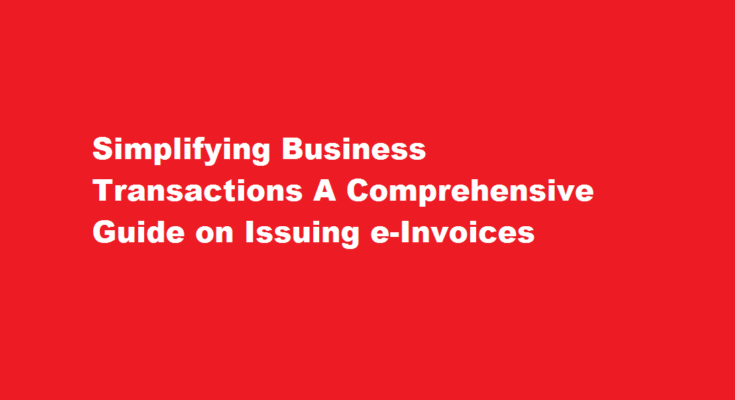Introduction
In an increasingly digitized world, businesses are transitioning from traditional paper-based invoicing to electronic invoicing, also known as e-invoicing. This streamlined and efficient method offers numerous advantages over its paper counterpart. In this article, we will explore the concept of e-invoicing, its benefits, and provide a step-by-step guide on how to issue e-invoices.
Understanding e-Invoicing
E-invoicing refers to the electronic exchange of invoice data between a supplier and a buyer, eliminating the need for paper documents. Instead, invoices are generated, sent, received, and stored digitally. This process significantly reduces manual data entry, minimizes errors, and improves transaction speed. E-invoicing systems often integrate with accounting software, simplifying the overall billing process.
Benefits of e-Invoicing
Adopting e-invoicing offers several advantages for businesses. Firstly, it enhances efficiency by automating invoice generation and delivery, reducing the time and effort required. Secondly, e-invoices are more accurate, as the chances of manual errors are greatly reduced. Additionally, businesses can benefit from improved cash flow management, faster payment processing, and enhanced security due to encrypted data transmission.
Step-by-Step Guide on Issuing e-Invoices
Choose an e-Invoicing Solution
Begin by selecting a suitable e-invoicing solution that aligns with your business needs. Research different software providers and consider factors such as pricing, integration capabilities, user-friendliness, and customer support.
Set Up Your Account
Once you have chosen an e-invoicing solution, sign up and create an account. Provide the necessary information, including your company details, contact information, and preferred payment methods. Verify your account if required.
Customize Your Invoice Template:
Most e-invoicing solutions offer customizable invoice templates. Tailor the template to reflect your brand identity by adding your company logo, colors, and relevant contact information. Ensure that the template complies with local invoicing regulations and includes all necessary fields, such as invoice number, date, payment terms, and itemized details.
Enter Invoice Details
Fill in the required fields in the e-invoice template with accurate information. Include the recipient’s contact details, a clear description of the products or services provided, quantity, unit price, taxes, and any applicable discounts. Double-check all details to ensure accuracy.
Add Supporting Documents
Attach any supporting documents relevant to the invoice, such as purchase orders, delivery notes, or contracts. This helps provide transparency and facilitates quicker payment processing.
Review and Validate the Invoice
Thoroughly review the invoice for any errors or omissions. Validate the invoice to ensure compliance with relevant regulations, such as tax requirements or invoicing standards specific to your industry.
Send the e-Invoice
Choose the preferred method of delivery, such as email or a secure online portal. Include a professional message along with the invoice, thanking the recipient for their business and providing instructions for payment.
Track and Manage Payments
Use the e-invoicing software’s tracking capabilities to monitor the status of your invoices. Keep a record of sent invoices, track when they are viewed by the recipient, and receive notifications for due or overdue payments. This feature enables proactive follow-ups and helps maintain a healthy cash flow.
Frequently Asked Questions
What is the rule for e-invoicing?
As per Rule 138A(2) of CGST Rules, where e-invoicing is applicable, “the Quick Reference (QR) code having an embedded Invoice Reference Number (IRN) in it, may be produced electronically, for verification by the proper officer, in lieu of the physical copy of such tax invoice.”
What are the parameters for the invoice?
There are four parameters based on which IRN is generated: Seller GSTIN, invoice number, FY in YYYY-YY, and document type (INV/DN/CN). IRP generates the invoice reference number (IRN), digitally signs the invoice and creates a QR code in Output JSON for the supplier.
Conclusion
Embracing e-invoicing can revolutionize your business’s billing process, offering increased efficiency, accuracy, and improved cash flow management. By following the step-by-step guide outlined above, you can seamlessly transition from traditional paper-based invoicing to issuing e-invoices. Keep in mind that continuous learning and adapting to new technologies are key to staying ahead in the ever-evolving digital landscape of business transactions.
Read Also : A Comprehensive Guide on Issuing Credit Notes



